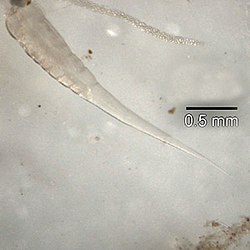Pinworm (parasite)
| Pinworm | |
|---|---|
 |
|
| Pinworms(U.S.)/Threadworms(U.K.) (Enterobius vermicularis). | |
| Scientific classification | |
| Kingdom: | Animalia |
| Phylum: | Nematoda |
| Class: | Secernentea |
| Subclass: | Spiruria |
| Order: | Oxyurida |
| Family: | Oxyuridae |
| Genus: | Enterobius |
| Species | |
|
|
The pinworm (species Enterobius vermicularis), also known as threadworm (in the United Kingdom and Australasia) or seatworm, is a parasitic worm. It is a nematode (roundworm) and a common intestinal parasite or helminth, especially in humans. The medical condition associated with pinworm infestation is known as pinworm infection (enterobiasis) (a type of helminthiasis) or less precisely as oxyuriasis in reference to the family Oxyuridae.
Other than human, Enterobius vermicularis were reported from bonnet macaque. Other species seen in primates include Enterobius buckleyi in Orangutan and Enterobius anthropopitheci in chimpanzee. Enterobius vermicularis is common in human children and transmitted via the faecal-oral route. Humans are the only natural host of Enterobius vermicularis.Enterobius gregorii, another human species is morphologically indistinguishable from Enterobius vermicularis except the spicule size. Throughout this article, the word "pinworm" refers to Enterobius. In British usage, however, pinworm refers to Strongyloides, while Enterobius is called threadworm.
The pinworm (genus Enterobius) is a type of roundworm (nematode), and three species of pinworm have been identified with certainty. Humans are hosts only to Enterobius vermicularis (formerly Oxyurias vermicularis).Chimpanzees are host to Enterobius anthropopitheci, which is morphologically distinguishable from the human pinworm. Hugot (1983) claims another species affects humans, Enterobius gregorii, which is supposedly a sister species of E. vermicularis, and has a slightly smaller spicule (i.e., sexual organ). Its existence is controversial, however; Totkova et al. (2003) consider the evidence to be insufficient, and Hasegawa et al. (2006) contend that E. gregorii is a younger stage of E. vermicularis. Regardless of its status as a distinct species, E. gregorii is considered clinically identical to E. vermicularis.
...
Wikipedia
